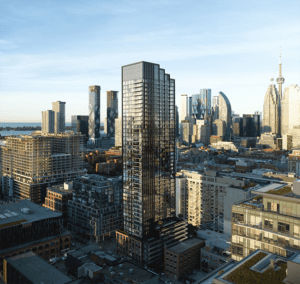The dream of owning a home is a powerful one, but sometimes, unforeseen circumstances can make it difficult for homeowners to keep up with their mortgage payments. When this happens, the lender may initiate a legal process called foreclosure. It’s a term that can sound daunting, and understanding what it entails is crucial for both homeowners and those looking to potentially purchase a foreclosed property.
In simple terms, foreclosure is the legal process by which a lender (usually a bank or mortgage company) takes possession of a property when the borrower fails to make the agreed-upon mortgage payments. Think of your mortgage as a loan secured by your house. If you don’t repay the loan according to the terms of your agreement, the lender has the right to reclaim their security – the property itself.
Here in Toronto, and across Ontario, the foreclosure process follows a specific legal framework designed to protect the rights of both the lender and the borrower, although the ultimate goal is the lender recovering their investment.
Why Does Foreclosure Happen?
Several factors can lead to a homeowner falling behind on their mortgage payments and potentially facing foreclosure. These can include:
Job Loss: The Unforeseen Unemployment Shock
Losing a job can be a devastating blow to a household’s finances, particularly when a significant portion of income is allocated to mortgage payments. In a city like Toronto, with its diverse but competitive job market, job loss can occur across various sectors. The immediate impact can be a sudden inability to meet monthly mortgage obligations. While employment insurance (EI) can provide temporary relief, it often doesn’t fully replace lost income, leaving a significant shortfall. The duration of unemployment can also be unpredictable, turning a short-term setback into a long-term financial crisis that puts homeownership at risk. The stress and uncertainty associated with job loss can further complicate efforts to manage finances and find solutions.
Medical Expenses: The Heavy Burden of Illness
Unexpected and significant medical expenses can quickly derail even the most carefully planned budgets. In Ontario, while we have a public healthcare system, many costs aren’t fully covered, including certain medications, therapies, dental care, and specialized treatments. A serious illness affecting the homeowner or a family member can lead to a double whammy: reduced income due to inability to work and a surge in out-of-pocket medical costs. These financial pressures can make it incredibly challenging to keep up with mortgage payments, forcing difficult choices between healthcare and housing. The emotional toll of illness further compounds the financial strain.
Divorce or Separation: The Financial Repercussions of Relationship Breakdown
The breakdown of a marriage or common-law partnership often leads to significant financial restructuring. Maintaining two separate households is typically more expensive than running one. The division of assets, including the family home, can be complex and may involve one partner needing to take on the full mortgage burden while potentially facing reduced income or needing to make equalization payments. Legal fees associated with separation and divorce can also be substantial. The emotional upheaval of this life change can further impact financial decision-making and the ability to manage mortgage obligations. In a high-cost housing market like Toronto, navigating these financial complexities after separation can be particularly challenging.
Economic Downturns: The Impact of Broader Financial Instability
Broader economic issues can have a ripple effect on individual homeowners. Recessions, rising interest rates, and inflation can all contribute to mortgage stress. When the economy slows down, businesses may downsize, leading to increased unemployment (as mentioned earlier). Rising interest rates directly impact variable-rate mortgages, increasing monthly payments and making homeownership less affordable. Even those with fixed-rate mortgages may feel the pinch as other living costs rise due to inflation, leaving less disposable income for mortgage payments. In a city like Toronto, where housing affordability is already a significant concern, economic downturns can exacerbate these challenges and push more homeowners towards financial distress.
Unforeseen Expenses: The Unexpected Curveballs of Life
Life is full of surprises, and not all of them are pleasant. Major unexpected expenses can strain even healthy budgets. These can include:
- Major Home Repairs: Furnaces break down, roofs leak, and unexpected structural issues can arise, requiring significant and immediate outlays of cash.
- Vehicle Issues: Essential transportation breaking down can lead to costly repairs or the need to purchase a new vehicle.
- Family Emergencies: Unexpected travel costs, funeral expenses, or providing support to other family members in crisis can create significant financial burdens.
- Natural Disasters: While less common in Toronto in some forms, severe weather events can still cause property damage requiring costly repairs not fully covered by insurance.
These unforeseen events can create a sudden financial shock, making it difficult to meet regular mortgage obligations. Without a substantial emergency fund, homeowners can quickly find themselves in a precarious financial situation.
Understanding these various pressures highlights the vulnerability that homeowners can face. While homeownership is a significant achievement, it also comes with ongoing financial responsibilities, and unexpected life events can unfortunately create circumstances that lead to the difficult path of foreclosure. Being aware of these potential pitfalls underscores the importance of financial planning, having emergency savings, and seeking help early if financial difficulties arise.
The General Stages of Foreclosure in Ontario:
While the specifics can vary slightly, the foreclosure process in Ontario generally involves these key stages:
-
Mortgage Default: This occurs when a homeowner misses mortgage payments, violating the terms of their mortgage agreement. Lenders typically have a grace period, but after a certain number of missed payments, they can take action.
-
Demand Letter (Notice of Default): The lender will send a formal letter to the homeowner demanding that they bring their mortgage payments up to date, including any outstanding interest and penalties, within a specified timeframe. This letter outlines the amount owed and the lender’s intention to pursue legal action if the default isn’t cured.
-
Statement of Claim (Commencement of Legal Action): If the homeowner fails to remedy the default within the given timeframe, the lender can file a Statement of Claim with the Ontario Superior Court of Justice. This officially begins the foreclosure lawsuit. The homeowner will be served with this document and has a limited time to file a Statement of Defence.
-
Certificate of Pending Litigation (CPL): The lender will typically register a Certificate of Pending Litigation (CPL) on the property title. This serves as public notice that a legal action concerning the property is underway.
-
Pleadings and Potential Resolutions: Both the lender and the homeowner will exchange legal documents (pleadings). During this stage, there might be opportunities for negotiation, such as a repayment plan or a mortgage reinstatement agreement. The homeowner may also try to sell the property themselves to pay off the outstanding mortgage.
-
Judgment: If no resolution is reached, the lender can apply for a judgment from the court. This judgment typically outlines the amount owed and declares that the homeowner is in default. The court may order a judicial sale of the property.
-
Sale Process: If a judicial sale is ordered, the court will oversee the process of selling the property. This usually involves listing the property with a real estate agent and a court-approved sale process. The proceeds from the sale are used to pay off the outstanding mortgage, legal fees, and other costs.
-
Possession: Once the sale is finalized and approved by the court, the new buyer takes possession of the property. If the homeowner still resides in the property, a court order for possession may be required to have them vacate.
What Does Foreclosure Mean for Potential Buyers?
Foreclosed properties can sometimes present opportunities for buyers to purchase a home at a potentially lower price than market value. However, it’s crucial to understand the nuances:
- “As-Is” Condition: Foreclosed properties are often sold “as-is,” meaning the buyer is responsible for any necessary repairs or maintenance. Thorough inspection is essential.
- Limited Information: The lender may have limited knowledge of the property’s history or condition.
- Potential for Competition: Well-priced foreclosures can attract significant interest from other buyers.
- The Process Can Be Lengthy: Purchasing a foreclosed property can sometimes involve a more complex and time-consuming process due to court involvement.
If You’re Facing Potential Foreclosure:
If you’re a homeowner struggling with mortgage payments, it’s vital to take action as early as possible. Here are some steps you can take:
- Communicate with Your Lender: Explain your situation and explore potential options like a payment plan, mortgage modification, or forbearance.
- Seek Financial Counseling: A non-profit credit counseling agency can provide guidance and help you explore your options.
- Explore Selling Your Property: Selling your home before the foreclosure process is complete can allow you more control and potentially avoid the negative consequences of foreclosure on your credit history.
- Seek Legal Advice: A real estate lawyer can explain your rights and obligations and guide you through the legal process.
Foreclosure is a serious situation with significant consequences. Understanding the process, whether you’re a homeowner facing difficulties or a potential buyer, is essential for navigating the complexities of the real estate market. If you have any questions about foreclosure or other real estate matters here in Toronto, please don’t hesitate to reach out. I’m here to help you understand your options and make informed decisions. Contact me at 647-995-3391 or via email at [email protected]. You can also visit my website by clicking here.





